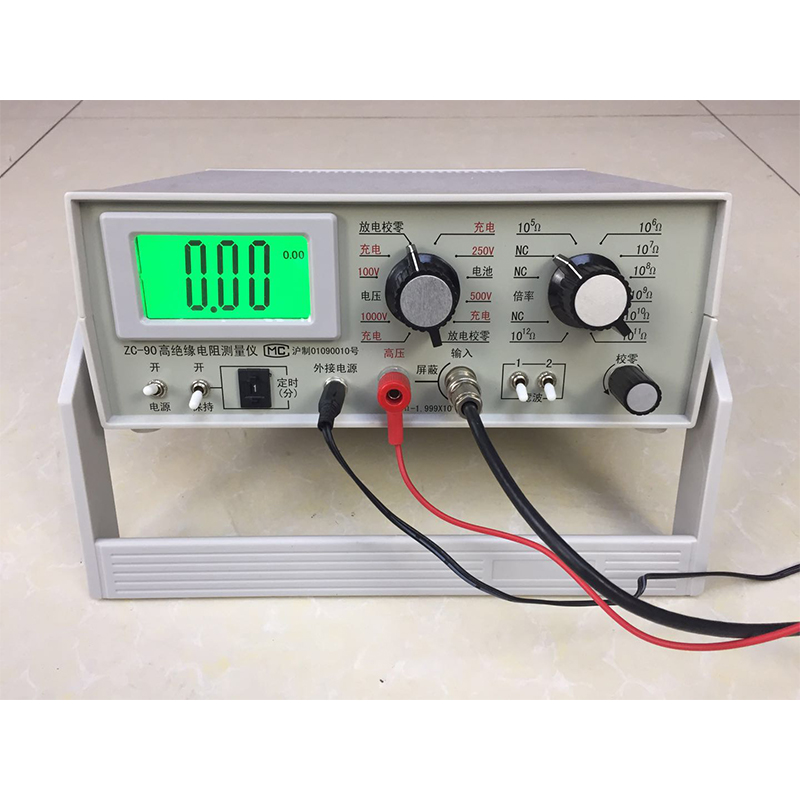High Insulation Resistance Tester – Reliable, Accurate, Advanced Measurement Solutions
- Introduction to the high insulation resistance tester
and its significance. - Analysis of emerging technological advancements in insulation resistance testing.
- Comparative analysis of leading high insulation resistance tester manufacturers and exporters.
- Evaluating technical specifications and performance data.
- The value of customized solutions in insulation resistance testing.
- Case studies highlighting real-world applications and results.
- Conclusion: Selecting the optimal high insulation resistance tester company for your requirements.

(high insulation resistance tester)
Understanding the High Insulation Resistance Tester: Importance, Market Trends & Use Cases
High insulation resistance testers have become pivotal in modern electrical testing and safety assurance. As industrial systems become more complex and regulatory requirements tighten, the demand for reliable and precise insulation resistance measurement tools has intensified. The global market for insulation resistance testers is projected to surpass $750 million by 2027, indicating rapidly increasing adoption across energy, transportation, aerospace, manufacturing, and utility sectors. These testers are fundamental to safeguarding equipment from insulation breakdowns, which, according to EPRI, account for over 45% of unexpected equipment failures in energy-intensive industries. Ensuring high-quality insulation measurement extends equipment lifespan, minimizes downtime, and fortifies operational safety.
The role of a high insulation resistance tester is to accurately measure and record the resistance between electrical conductors and their insulation materials. This is critical for preemptive maintenance, verification of new installations, and adherence to international safety standards such as IEC 60270 and IEEE 43. Standard insulation resistance testers typically measure up to 1 GΩ, while high-end units can test resistances above 10 TΩ with voltages up to 10kV, supporting more advanced diagnostic applications. This capacity for ultra-high resistance measurement and data logging has become a top selection criterion for industries aiming to future-proof their electrical infrastructures.
Cutting-edge Technological Advances in Insulation Resistance Testing
The last decade has seen significant innovation in insulation resistance testing. Advanced testers are now equipped with microprocessor-based intelligent control, real-time graphing of resistance decay, and wireless data transmission for remote monitoring. Integration with industrial protocols (Modbus, Ethernet/IP) enables seamless incorporation into SCADA systems and Industry 4.0 frameworks.
Additionally, the inclusion of temperature correction algorithms ensures measurement accuracy despite environmental fluctuations, while automatic discharge mechanisms increase operator safety. Modern testers feature built-in memory capable of storing up to 100,000 measurements, easing compliance with audit and documentation requirements. With reinforced casing (IP67/IP54 ratings) and rechargeable lithium-ion batteries providing more than 8 hours of continuous operation, these instruments are sufficiently robust for harsh field environments and factory deployment alike. Touchscreen interfaces, QR-code data tagging, and one-click report exporting are further shaping the user experience.
Comparative Review: Top High Insulation Resistance Tester Manufacturers & Exporters
The choice of a high insulation resistance tester often hinges on the reputation and global reach of its manufacturer. Below is a comparative analysis of three leading companies in the field, focused on their technical features, after-sales support, certifications, and delivery capabilities.
| Manufacturer/Exporter | Max Test Voltage (V) | Measurement Range | Certifications | Data Storage | Global Support | Avg. Delivery Time | Notable Clients |
|---|---|---|---|---|---|---|---|
| Metrix Instruments | 10,000 | 10 kΩ - 10 TΩ | CE, IEC, ISO9001 | 100,000 records | 24/7 (50+ countries) | 10-15 days | Siemens, Schneider Electric |
| HiTest Corp. | 5,000 | 1 MΩ - 1 TΩ | UL, RoHS | 50,000 records | Europe, N. America | 15-20 days | Toyota, ABB |
| Rongtai Electric | 15,000 | 10 kΩ - 20 TΩ | CE, ISO/IEC 17025 | 80,000 records | Asia-Pacific, Middle East | 7-12 days | State Grid Corp., PetroChina |
As detailed, while all manufacturers offer robust testing capabilities, key differentiators often include certifications relevant to target markets, support infrastructure, and data management features. Exporters such as Rongtai Electric leverage regional distribution centers for faster fulfillment, while HiTest Corp. specializes in solutions calibrated for automotive environments.
Technical Superiority: Measuring Accuracy & Performance
In evaluating a high insulation resistance tester for organizational needs, key performance parameters must be critically analyzed. These include test voltage range, measurement accuracy, operational safety, and environmental durability. Precision is vital: high-quality testers offer ±2% accuracy over an extended range, automatic polarization index (PI) and dielectric absorption ratio (DAR) calculations, and advanced leakage current measurement down to nano-ampere levels.
Durability is assured via triple-shielded test leads to prevent measurement distortion and reinforced input circuits to handle transient surges up to 12 kV. Outstanding EMC shielding secures the instrument from industrial electromagnetic noise, ensuring reproducibility in challenging conditions. Real-world test campaigns demonstrate that using testers with integrated safety circuitry reduces the risk of arc-flash by up to 85% compared to conventional equipment. Additionally, cloud-enabled data platforms allow team-based remote review, bolstering traceability and accelerating diagnostic workflows.
Tailored Solutions from High Insulation Resistance Tester Manufacturers
Off-the-shelf solutions may not always fit the diverse requirements across industries. Recognizing unique project parameters, many high insulation resistance tester companies now offer fully customized systems, addressing voltage range, user interface, integration, and casing form factor preferences. Such tailored testers often feature:
- Application-specific voltage step profiles for unique insulation materials.
- Multi-channel simultaneous testing capabilities (up to 24 channels).
- Embedded APIs for MES/SCADA integration, fast-tracked by manufacturers’ development teams.
- Environmental hardening for marine, mining, or high-altitude operations.
- Battery or solar-powered autonomous configurations for remote infrastructure inspection.
Manufacturers invest in collaborative engineering, running simulation models and prototype field trials to guarantee solution efficacy. The result is a measurable reduction in maintenance costs (up to 23% annualized in high-voltage substations) and increased ROI within two years of deployment. Exporters with global engineering support networks further help integrate these bespoke systems seamlessly into established workflows.
Successful Implementation: Application Cases & Measurable Impact
Insulation resistance testers are critical in several sectors, and their deployment has demonstrated substantial returns. Consider an application in renewable energy: one leading utility implemented a multi-channel high insulation resistance tester solution to monitor over 1,000 wind turbine installations. This upgrade led to a 60% reduction in unscheduled shutdowns and improved predictive maintenance planning, reducing replacement part costs by $1.8 million per annum.
In heavy manufacturing, rigorous insulation resistance monitoring curtailed incident response time from 12 hours to less than 3 hours, directly improving production uptimes. Below is a summary of outcomes from recent industry case studies:
| Sector | Insulation Resistance Tester Solution | Initial Issue | Measured Benefit |
|---|---|---|---|
| Renewable Energy | Multi-channel; Remote Data Sync | Frequent turbine downtime | ↓60% outages, $1.8M/year saved |
| Automotive Production | Customized, High-Throughput | Assembly line quality failures | ↓45% QA rechecks, ↑16% throughput |
| Data Centers | Precision, Automated Logging | Insulation audit bottlenecks | ↓70% audit time, ↑24% compliance |
These cases highlight that investing in advanced insulation resistance testing directly correlates with increased asset reliability, reduced operational risks, and measurable cost savings.
Finding the Ideal High Insulation Resistance Tester Company: Factors to Consider
In conclusion, the process of selecting the right high insulation resistance tester—and by extension, an outstanding high insulation resistance tester company or exporter—should be guided not only by hardware specifications, but also by after-sales service, customization capabilities, data security compliance, and logistical support. With emerging manufacturers continually enhancing the state of technology, customers are empowered to demand solutions that marry accuracy, efficiency, and robust field performance.
When evaluating options, prioritize transparent technical documentation, verifiable client references, and scalable support across global operations. As shown by comparative analyses and application case studies, the best partnerships are formed with manufacturers who can combine deep domain expertise, agile customization, and a long-term commitment to operational excellence. The right choice will not only ensure safety compliance, but also deliver strategic value far into the future.

(high insulation resistance tester)
FAQS on high insulation resistance tester
Q: What is a high insulation resistance tester?
A: A high insulation resistance tester is an electronic device used to measure the insulation resistance of electrical equipment. It ensures safety by detecting insulation breakdowns. These testers are widely used in maintenance and quality checks.Q: How do I choose a reliable high insulation resistance tester company?
A: Look for companies with certifications, positive customer reviews, and after-sales support. Consider their experience in the field and the range of products they offer. Comparing prices and warranties is also advisable.Q: What distinguishes reputable high insulation resistance tester manufacturers?
A: Reputable manufacturers use high-quality components and adhere to international standards. They offer detailed product documentation and calibration certificates. Reliable support and customization options also set them apart.Q: Are there high insulation resistance tester exporters that provide global shipping?
A: Yes, many high insulation resistance tester exporters provide worldwide shipping options. They often have distributors or partners in multiple countries. Check for their export experience and international certifications.Q: What applications are ideal for using a high insulation resistance tester?
A: High insulation resistance testers are essential in industrial, electrical, and utility sectors. They are used for routine maintenance, type testing, and troubleshooting. These testers help in ensuring the safety and longevity of electrical equipment.-
Why the Conductor Resistance Constant Temperature Measurement Machine Redefines Precision
NewsJun.20,2025
-
Reliable Testing Starts Here: Why the High Insulation Resistance Measuring Instrument Is a Must-Have
NewsJun.20,2025
-
Flexible Cable Flexing Test Equipment: The Precision Standard for Cable Durability and Performance Testing
NewsJun.20,2025
-
Digital Measurement Projector: Precision Visualization for Modern Manufacturing
NewsJun.20,2025
-
Computer Control Electronic Tensile Tester: Precision and Power for the Modern Metal Industry
NewsJun.20,2025
-
Cable Spark Tester: Your Ultimate Insulation Assurance for Wire and Cable Testing
NewsJun.20,2025
 Copyright © 2025 Hebei Fangyuan Instrument & Equipment Co.,Ltd. All Rights Reserved. Sitemap | Privacy Policy
Copyright © 2025 Hebei Fangyuan Instrument & Equipment Co.,Ltd. All Rights Reserved. Sitemap | Privacy Policy
